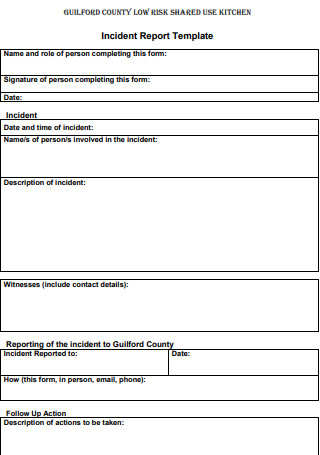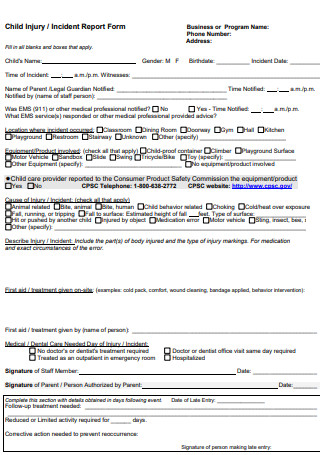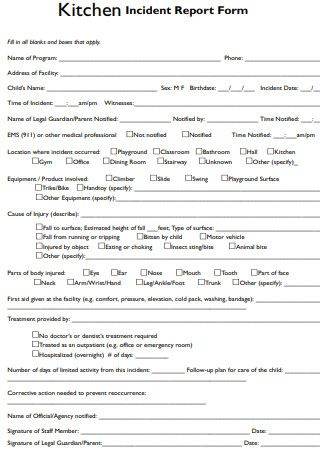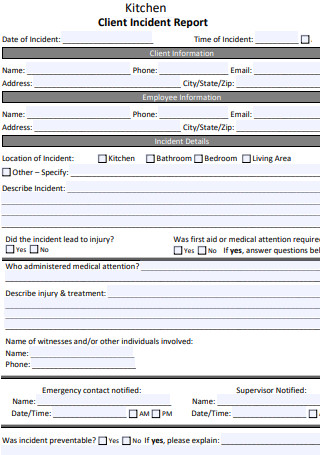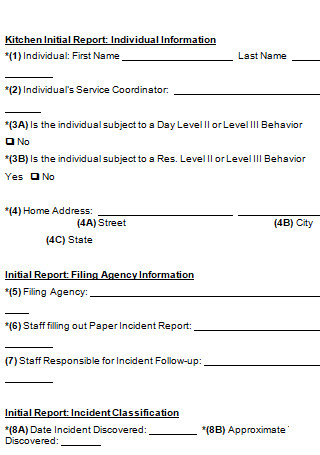4+ SAMPLE Kitchen Incident Report
FREE Kitchen Incident Report s to Download
4+ SAMPLE Kitchen Incident Report
What is a Kitchen Incident Report?
Importance of an Incident Report
Benefits of Using an Incident Report
How to Write a Kitchen Incident Report
What are the Types of Incidents that Need Reporting?
FAQs
Why do employees need to report Incidents?
Why is there a need to investigate Incidents?
What is the difference between a kitchen incident report from a police report?
What is a Kitchen Incident Report?
A kitchen Incident Report is a formal document that describes the circumstances surrounding a workplace event. The report is generally about a worksite accident or injury, but it may also be about other odd worksite events including near misses, security failures, property and equipment damage, and health and safety concerns. Following an event or injury within the kitchen, incident reports should be prepared as quickly as feasible. The report may be utilized or disseminated solely inside the kitchen, but if the situation is serious enough, it may be submitted to insurers, regulatory authorities, or even the police. There are sample incident reports in the kitchen that you can use as a reference when your company kitchen encounters incidents.
Importance of an Incident Report
Any incident involving worker safety should be documented, no matter how minor it appears. After the event has occurred and any wounded individuals have been taken care of, an inquiry into what transpired should be conducted as quickly as feasible. The report that is created as a consequence should detail everything that happened. There have been failures in the kitchen’s Safety standards, according to incident reports. As a result, it is critical to report and document an event in order to identify the risks, failures, and dangers that contributed to the occurrence.
These reports may be used to assist companies to make the required adjustments, improvements, and corrective steps to avoid future occurrences. An incident report will aid in the prevention of more serious incidents, the improvement of existing health and safety procedures, the saving of time and resources, the protection of the company from financial losses and a negative reputation, and the instillation of employee trust.
Benefits of Using an Incident Report
Incident reporting is a well-established concept that was originally designed to promote and improve workplace safety. However, the majority of employees continue to disobey this procedure. Management and employees should understand why incident reporting may assist a company not only enhance its safety but also differentiate itself from competitors and, most importantly, establish safe employees and will have a healthy working environment and culture.
How to Write a Kitchen Incident Report
Since an incident report is an official record of the facts surrounding a kitchen incident, injuries, or near misses, it’s important to keep it up to date. Its main goal is to figure out what happened and how it happened in order to prevent such events in the future. A minimum of the following should be included in every incident report you submit. If you don’t want to start from scratch and waste time upon facing an incident, then there are available templates that you can use. Check out the provided example of incident report in kitchen which you can immediately make use of while in a situation where you need to promptly create a Report.
Step 1: Introduction
The who, what, when and where of the occurrence are included in the first section of the incident report form. Include the names of everyone who was involved in the incident. If names aren’t accessible, you can refer to the person’s position in the occurrence, such as chef, sous chef, and so on. In no more than three phrases, summarize the occurrence, for example, a stove caught fire, inflicting minor damage to a room. Include the date and time of the incident. If a precise time cannot be determined, an estimate can be used. Make a note of the incident’s location, and be as detailed as possible, such as if it occurred in a conference room or on which level of which specific building. Don’t forget to include the type of event, such as injury, near-miss, property damage, or theft.
Step 2: General Information and Setting
The most basic information is needed in an incident report, such as the incident’s exact location, time, and date. If additional research is required, this will also be useful information. This refers to the physical and environmental factors that may have played a role in the occurrence. This might also include any possible risks discovered in the incident location. The names of those involved, as well as their Titles and departments. If you are wondering why you still need to elaborate if you have given the summary, then the direct answer is that supplying as much accurate information as possible will assist authorities when they will be reviewing the scenario of the incident.
Step 3: The Incident’s Narrative Description
Include the chronology of events as well as the incident’s outcomes, such as any injuries. The incident’s story, as well as the facts of why it became an incident. Include the type of damage, its severity, and the affected bodily parts. The movement of the persons involved at the time of the occurrence. You would need to add an accurate narrative description because authorities will find it helpful to go over the content of the report with as much information regarding the incident as possible. Without a Narrative description, the authorities may not picture out the incident without a narrative recollection.
Step 4: Administered Treatment
If there are required treatments, this is the step where you will be writing it out. This includes any early therapy, help, or drugs offered to those who have been afflicted. This material is necessary to comprehend employee rehabilitation and similar topics. Be sure to state here what the immediate administered treatment was given to the affected kitchen staff so that authorities will be aware of the state of the sustained injuries and the state of the healing process. Or if any immediate treatment still needs to be performed then at least the medical professionals will be alerted of the injuries that were given first aid.
Step 5: Witnesses Identity and Statements
This is the step where you will be collecting the names of the witness that were present to spectate the incident with their very own eyes. You should also be getting their Statements of the recollection of the incident. You can also include the names or statements of other workers involved. Pertains to statements of people present during the incident. Collecting witnesses will prove vital in order for authorities to better recollect and paint the picture of the scenario of the incident. Otherwise, without the witnesses, they will have a much harder time figuring out the occurrence of the incident and how it led to such.
Step 6: Supporting Evidence
Showcase the scene’s damaged goods and Equipment, as well as video and different perspective pictures. Affect some assets, materials, facilities, and equipment that were harmed as a result of the incident. This will help assist the authorities when they will be reviewing the incident report in the kitchen and assess the situation much better than lacking any other supporting pieces of evidence. Just as any report
What are the Types of Incidents that Need Reporting?
There are different types of incidents that people may not truly be aware of their difference. Of course, in a state of panic, no one can expect the person who will be writing the report to know right away the types of incidents. But it is still important to know prior to the occurrence of any incidents regarding the different types in order to be aware of the situation. These four categories of incidents should be recorded in any company’s incident reporting procedure.
FAQs
Why do employees need to report Incidents?
In the case of an incident, fast and effective first aid and medical care are critical in caring for workers, subcontractors, and visitors. Incidents might be little, serious, or major, but they are all incidents that must be examined to determine what occurred and how they can be avoided in the future. Employees are encouraged to report accidents and injuries so that their employers may ensure that their kitchen staff receives proper medical care as quickly as possible. Minor scrapes that were untreated have resulted in fatalities. Furthermore, timely and efficient reporting of hazards, incidents and other occurrences that pose an actual or potential risk to health and safety or environmental damage is required so that risk assessment can identify appropriate corrective actions. Depending on the severity of the hazard or occurrence, quick action must be done to prevent more injuries.
Why is there a need to investigate Incidents?
The main objective for incident investigation is to try to determine the core factors that contributed to the occurrence so that your organization or kitchen staff has a better chance of preventing similar accidents from occurring in the future. Determining the facts surrounding the incident can also aid in the identification of control measures that may be implemented to prevent future incidents. It’s also critical to share the findings of any incident investigation with the rest of your team so that everyone is aware of the possible dangers and any modifications the company has made to a process or procedure, as well as the reasons for those changes. Corrective actions may be implemented upon further investigation.
What is the difference between a kitchen incident report from a police report?
These two words are sometimes confused as synonyms. The person who completes it, though, is the one who makes the most impact. A police report is, obviously, a comprehensive account of a crime written by an officer or other police department official who was present at the crime scene. An incident report, on the other hand, can be prepared by anybody who wishes to record any occurrences that may or may not have caused harm to someone or anything, as described above. An incident report can be used as a supporting document to an inquiry or analysis of occurrences, whereas a police report necessitates an investigation.
In our fast-paced working environment, things don’t always go as planned, and employees may be hurt while performing the task for which they were hired. Kitchen staff may encounter scalding water, damaged appliances, broken glassware, etc. It is critical to report incidents as soon as they occur or as soon as a mess takes place. Reporting isn’t about assigning blame; it’s about detecting potential workplace concerns and preventing them from recurring. Be sure to check out the provided kitchen incident report sample that you can use for the betterment of your company’s kitchen staff. Along with being armed with the knowledge of this article’s input, you are more than ready to write out a kitchen fire incident report when a fire-related incident comes.

